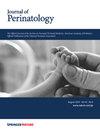Association of hyperglycemia in extremely preterm infants with neurodevelopmental outcomes at 18 months of corrected age
IF 2.4
3区 医学
Q2 OBSTETRICS & GYNECOLOGY
引用次数: 0
Abstract
To investigate the impact of hyperglycemia on the neurodevelopmental outcomes in extremely preterm infants. This single-center retrospective cohort study enrolled extremely preterm infants born at <28 weeks of gestation. Hyperglycemia was defined as a blood glucose level of >15 mmol/L. The Kyoto Scale of Psychological Development at 18 months of corrected age was used for neurodevelopmental assessment, and a developmental quotient (DQ) of ≥85 was defined as normal. Among the 102 surviving extremely preterm infants, 54 (53%) had hyperglycemia. The hyperglycemia group had lower DQ (81.0 ± 19.3 vs. 91.1 ± 15.3, P < 0.01) and decreased normal DQ rate (37% vs. 75%, P < 0.001). In the multiple logistic regression models, hyperglycemia was significantly associated with lower normal DQ rates (P = 0.03). Hyperglycemia, defined as a blood glucose level of >15 mmol/L, was independently negatively associated with normal DQ after adjusting for confounders.

极早产儿高血糖与矫正年龄18个月时神经发育结局的关系
目的:探讨高血糖对极早产儿神经发育结局的影响。研究设计:这项单中心回顾性队列研究纳入了15mmol /L的极早产儿。采用18月龄京都心理发展量表进行神经发育评估,发育商(DQ)≥85为正常。结果:102例存活的极早产儿中,54例(53%)有高血糖。高血糖组DQ较低(81.0±19.3 vs. 91.1±15.3,P)结论:调整混杂因素后,高血糖与正常DQ呈独立负相关,定义为血糖水平为>15 mmol/L。
本文章由计算机程序翻译,如有差异,请以英文原文为准。
求助全文
约1分钟内获得全文
求助全文
来源期刊

Journal of Perinatology
医学-妇产科学
CiteScore
5.40
自引率
6.90%
发文量
284
审稿时长
3-8 weeks
期刊介绍:
The Journal of Perinatology provides members of the perinatal/neonatal healthcare team with original information pertinent to improving maternal/fetal and neonatal care. We publish peer-reviewed clinical research articles, state-of-the art reviews, comments, quality improvement reports, and letters to the editor. Articles published in the Journal of Perinatology embrace the full scope of the specialty, including clinical, professional, political, administrative and educational aspects. The Journal also explores legal and ethical issues, neonatal technology and product development.
The Journal’s audience includes all those that participate in perinatal/neonatal care, including, but not limited to neonatologists, perinatologists, perinatal epidemiologists, pediatricians and pediatric subspecialists, surgeons, neonatal and perinatal nurses, respiratory therapists, pharmacists, social workers, dieticians, speech and hearing experts, other allied health professionals, as well as subspecialists who participate in patient care including radiologists, laboratory medicine and pathologists.
 求助内容:
求助内容: 应助结果提醒方式:
应助结果提醒方式:


